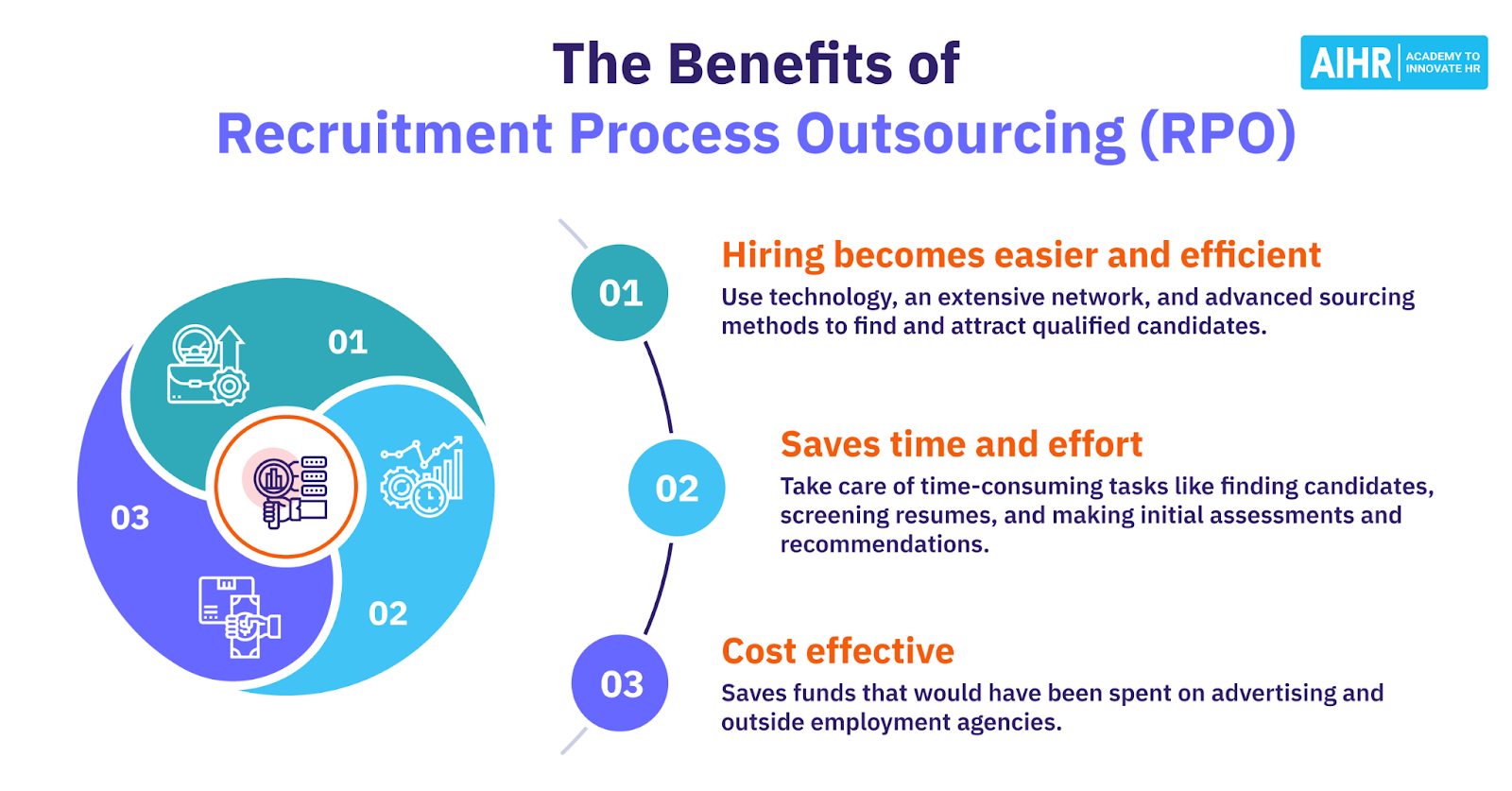For seasoned talent acquisition teams, RPO has shifted from an experimental solution to a proven method for managing scale, speed, and complexity. But as budgets tighten and hiring becomes more complex, one question keeps surfacing: Is the RPO cost really worth it?
You’re not just outsourcing recruitment tasks but also outcomes, accountability, and in many cases, strategic oversight. And that changes the cost conversation entirely. So let’s break it down: What drives recruitment process outsourcing cost, how can you assess value, and when does it pay off?
Understanding RPO Pricing Models
There’s no universal RPO pricing sheet. Instead, RPO recruitment service providers typically operate under a few common pricing models:
1. Cost-Per-Hire Model
You pay a fixed or variable amount for each successful hire. Ideal for project-based or high-volume hiring, but less predictable in cost planning.
2. Management Fee Model
You pay a monthly fee for the ongoing management of the recruitment process. This is often layered with performance-based bonuses or SLAs. Best suited for long-term partnerships.
3. Hybrid Models
Combining elements of cost-per-hire and monthly management fees. These allow flexibility but require strong performance tracking.
Remember that RPO pricing must match your hiring complexity and volume. A model that works for retail mass hiring may be a disaster in a tech hiring environment.
Read More: How RPO Works: A Step-by-Step Guide
What Drives RPO Cost?
Recruitment process outsourcing cost isn’t just a number, but a reflection of scope, complexity, and the value built into the partnership.
A few factors consistently drive up or down the investment:
- The difficulty of your talent market: Hiring for niche tech roles costs more than hiring for entry-level retail.
- Technology integration: RPOs using advanced ATS, CRMs, and AI tools may charge more upfront but reduce downstream costs.
- Geographic coverage: A global or multi-location setup requires more recruiters, compliance layers, and coordination.
- Depth of service: A full-cycle RPO will naturally cost more than just sourcing or screening support.
Think of it this way: You’re paying not just for capacity, but for capability.
Value Breakdown: What Are You Really Buying?
When evaluating the ROI of an RPO model, ask this: Would building this capability in-house give me the same outcome, faster and cheaper?
Here’s what you’re really buying:
- Speed to hire with pre-built talent pipelines
- Reduced time-to-fill and cost-per-hire metrics
- Access to passive talent pools
- Process standardization and compliance
- Global scalability on demand
- Technology + recruiter bundles that reduce infrastructure costs
A strong RPO recruitment service will act not just as an execution partner but as a capability builder.
When Is RPO a Cost-Effective Move?

Not every RPO investment delivers equal returns, and that’s precisely why timing and context matter. The right RPO model, deployed at the right moment, can shift the economics of hiring dramatically.
Say your internal TA team is operating at full capacity, and hiring demand keeps rising. Scaling in-house could mean months of internal onboarding and overhead. RPO, by contrast, plugs into your process quickly and flexibly.
Or consider market expansion. If you’re entering new geographies, especially international ones, building internal recruitment infrastructure is expensive and slow. RPO providers with established regional networks can help you hit the ground running. SHRM notes that aligning expectations is key to successful RPO partnerships, and when that alignment happens early, it accelerates delivery and reduces onboarding friction.
Struggling with high attrition or underwhelming hires? Many RPO partners specialize in rebuilding pipelines for long-term fit, not just quick fixes. Their data-backed approach can lift quality-of-hire over time.
Then there are the hard-to-fill roles. Think of a senior data scientist or a multilingual healthcare professional. RPO partners often have niche sourcing channels and passive candidate databases that your internal team may lack access to.
Finally, if you’re looking to bring consistency and transparency to your hiring decisions, RPO models powered by analytics and SLAs can help you move from guesswork to insight.
In all these cases, the recruitment process outsourcing cost shouldn’t be viewed as overhead, but a smart way to protect against hiring delays, poor fits, and missed opportunities.
Also read: RPO vs. Staffing: Which One Builds a Better Team (Faster)?
How Offshore RPO Models Reduce Cost and Expand Reach
Cost-saving is the obvious appeal of offshore RPO models, but it’s not the only reason companies choose them in 2025.
Global talent operations often need around-the-clock recruitment. Offshore partners fill that gap, offering 24/7 candidate sourcing, follow-ups, and scheduling, which speeds up the process significantly.
Resume submissions and candidate pipelines arrive faster, thanks to time zone advantages and high recruiter availability. Offshore teams also bring down your fixed costs, especially for sourcing and screening functions that are typically labor-intensive.
And for companies hiring in multilingual markets or working with diverse candidate pools, offshore recruiters with regional language skills and cultural familiarity are a serious asset.
Here’s the catch: value only materializes when your offshore RPO team is truly embedded into your hiring engine. That means shared systems, clear SLAs, and regular collaboration, instead of an isolated team operating off a checklist.
When done right, offshore RPO isn’t just a cheaper option. It’s a force multiplier for hiring reach, efficiency, and speed.
AI Integration in RPO and Its Impact on Hiring Efficiency and ROI
The most effective RPO providers today are bringing platforms, workflows, and intelligence to the table. And that’s where AI makes a measurable difference.
Instead of manually screening hundreds of resumes, AI tools now score candidates based on job fit, previous patterns, and predicted success metrics. This saves time and filters out noise before a human even reviews an application.
Predictive analytics takes it a step further by flagging candidates likely to perform well or stay longer, which directly influences quality-of-hire.
And the sourcing process? It’s increasingly automated. AI bots scan job boards, internal talent pools, and CRMs to identify suitable profiles within minutes, not hours.
Meanwhile, candidate engagement tools like AI chatbots handle FAQs, schedule interviews, and keep communication flowing without adding to your recruiters’ workload.
All of this automation doesn’t just lower operational effort. It amplifies ROI. When AI supports the RPO model, the result is faster hiring, better candidates, and less wasted recruiter bandwidth, often at a lower RPO cost than traditional models.
Evaluating True ROI With Metrics That Matter
You can’t justify cost without measuring value. So, how do you know your RPO partnership is working?
Track:
- Time-to-fill
- Cost-per-hire (pre and post RPO)
- Quality-of-hire (performance ratings, tenure)
- Hiring manager satisfaction
- Candidate experience NPS
- Pipeline diversity and reach
These aren’t vanity metrics, but indicators of how deeply integrated your RPO recruitment service is with your business goals.
To Conclude: RPO Is a Cost, But Also a Competitive Advantage
Here’s what no spreadsheet can fully capture: the strategic advantage of focusing internal HR on employer branding, retention, and engagement, while a trusted partner handles the tactical weight of recruitment.
Yes, the cost of outsourcing the recruitment process is real. But so is the cost of missed hires, poor candidate experience, overburdened HR teams, and unscalable processes.
RPO is not about saving money on recruiting. It’s about making smarter hiring investments that drive business growth.
Considering RPO for your business?
Explore how SPECTRAFORCE’s RPO recruitment services combine offshore agility, AI-driven efficiency, and deep domain expertise to deliver measurable results for global hiring teams.
FAQs
To evaluate if RPO’s value justifies its cost, you should compare your current cost-per-hire, time-to-fill, and quality-of-hire against projected RPO outcomes. If RPO improves these metrics while allowing your internal team to focus on strategic tasks, the investment is justified.
In 2025, the key factors that make RPO cost-effective are AI integration, offshore capabilities, scalable models, and the ability to embed seamlessly into your HR ecosystem, delivering outcomes beyond transactional hires.
Offshore RPO providers enhance ROI and reduce recruitment expenses by reducing overhead, offering around-the-clock support, and accelerating time-to-fill by tapping into broader talent pools at a lower cost.
AI screening tools reduce bias and human error, improve match accuracy, and save recruiters time. The result: better candidates, faster, and at a lower operational cost.
Data-backed KPIs like cost-per-hire, time-to-fill, and quality-of-hire help HR leaders track real ROI and ensure the RPO provider is meeting business goals, not just filling roles.



